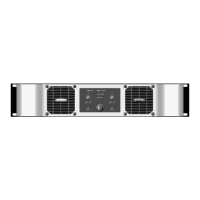the checks listed in Section 2. These checks will minimize the possibility of receiving a nasty surprise when turning on the
amplifier.
3.1 Initial Conditions
The start of each step assumes all switches are pre-set to the following positions:
z Mode Switch: Normal position.
z Level Controls: Both up (clockwise) fully.
3.2 Test Procedure
3.2.1 Turn-on Delay No Signal
No Load
Apply mains and check for the following:
Mains LED is on and red. Protect LED (red) and both temp. LEDS (yellow) flash together 5 times and then go off.
Switch on and observe the following:
After 2 seconds the operate LED is on and yellow. Fans are on at full speed. After another 2 seconds clip LEDS flash and
fans slow to idle.
3.2.2 DC Output Offset No Signal
No Load
With the input level controls turned fully clockwise, the DC offset for both channels should be less than ±100 millivolts. A large
DC offset usually indicates a failure in the output stage, though such an offset should have shut down the amplifier on a
DC/LFI signal.
3.2.3 Quiescent Power No Signal
No Load
While there is no published specification on quiescent power, it should be checked. A power draw with the fan operating
slowly will normally be less than 120 W (<800mA). If quiescent power greatly exceeds expectation, then turn the amplifier off
immediately and search for power supply or output failure. If quiescent draw exceeds expectation by a “small” amount, check
bias immediately.
3.2.4 Sensitivity (Gain) 1-kHz Sine Wave
No Load
Check that both level controls are full clockwise. Insert a 0.1V 1-kHz sine wave and measure 14.9V – 16.5V at the output of
each channel for the 2x1100, 11.7V – 13V at the output of each channel for the 2x650, 8V – 8.8V at the output of each
channel for the 4x300 .
3.2.5 Bridge Mono 1-kHz Sine Wave
No Load
Note: Always turn power to the amplifier off prior to changing the position of the Mode Switch. With the dual/mono switch in
the bridge mono position, insert a 0.45Vrms 1-kHz signal into channel one input. There should be signal present on both
channel outputs, equal in amplitude, with channel two 180 degrees out of polarity from channel one (see Fig. 2.3). Channel
one input level control should control the output level for both channels. Return the amplifier to stereo operation.
Figure 2.3 Bridge-Mono Waveform
CAUTION: If you are attempting to check or measure VI limiting, output power, or any other test which would require
the amplifier to produce large amounts of heat, the main module should be securely mounted inside the chassis. If
the module must be removed from the chassis, the test should be of very short duration.
WARNING: Do not connect any load to the Pulse power amplifier during these tests until specifically instructed to
do so.

